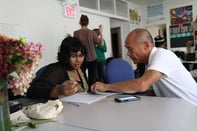Virtual Incubation to Build Businesses in America

With John Dyer | Director of Community and Corporate Affairs, White Mountains Community College
The following interview is with Jennifer Worth—the Program Manager of the Center for Workforce and Economic Development at the American Association of Community Colleges, John Dyer—the Director of Community and Corporate Affairs at White Mountains Community College and Sheneui Weber—the Executive Director of College Advancement and Economic Development at Long Beach City College. The three are speaking at a number of conferences across the country on the topic of virtual business incubation at American community colleges. There are 11 schools that are part of the Virtual Incubation Network Initiative; including Dyer and Weber’s home institutions, Rio Salado College, Indian River State College, North Iowa Community College, Mott Community College, Southeast Community College, Burlington Community College, Santa Fe Community College, Lorain County Community College and Northeast Wisconsin Technical College.
1. How did you first develop an interest in virtual business incubation?
Jennifer Worth: Here at AACC (American Association of Community Colleges) Centre for Workforce and Economic Development, we were funded by the Charles Stewart Mott Foundation, along with one of their key program officers… who really helped us build out a concept around virtual. To do that, we started out with a small research piece and we scanned the universe for who were the key colleges and partners in the field. … Our key partners [in] that consortium consisted of National Association for Community College Entrepreneurship (NACCE), the National Business Incubation Association, and then also the U.S. Small Business Administration. And with those leadership organizations, we also worked with 11 community colleges, all with differing shapes, sizes, demographics, service areas. … By having regular dialogue with all of those partners and pulling them together; we really showcased the variations across community colleges around small business and incubation supports. We took some of the learning that we found from those conversations and we actually put it together in a tangible toolkit, so that other colleges across the country could scale and build on those strengths, using it at their own unique local label market opportunities. … But I’ll ask my fellow colleagues, Sheneui and John who are two very different kinds of colleges to also add to that description.
Sheneui Weber: When we were first tapped for this project, it actually was a very interesting project; we weren’t very clear on what it was. But as we got into it, really my experience is that, it really is very good leadership on the part of AACC to bring these 11 community colleges—from very diverse communities—together to explore and discuss this topic on virtual incubation. The idea of assembling a toolkit I think really added to and really enriched the discussion and helped put a real interest out there in terms of community colleges thinking about working and supporting their business community.
John Dyer: I’d like to emphasize particularly that this is as much as anything about the leadership of the American Association of Community Colleges; the way they put this together and had it unfold.
2. What are the benefits of this type of support mechanism for business owners and local communities?
JW: … Community colleges can empower local business owners by growing more businesses that really tap into the wide array of business and personal education and just general supports that they offer. So that’s a pretty important concept because it strengthens the local labor market and economic base. We are also helping support more business owners and workers who have more flexible and affordable methods and manners for teaching and learning. We’re allowing these sites to then think about different ways for delivery.
We’re helping individual people in the community pursue their own dreams of starting a business, and that’s probably one of the most essential things. We’re helping them come up with their own ideas in a way that’s fundable and sustainable. That’s not just for people who are starting their own businesses but also for existing business who want to expand or grow what they’ve already been doing in an informed way. We want to talk with the colleges and help them think about some of the fundamental entrepreneurial skills that underpin quality workers. We did a lot of that with our partner, NACCE, they would actually argue that you should be teaching entrepreneurship skills to anyone across the country, no matter what sector they’re going into.
We had conversations together with our 11 colleges and partners around making sure that our concepts are sustainable and the funding models that we put forth really are the ones that make the most sense. So, we affectionately call them the “Whack-Pack” of community colleges. We try to make sure that colleges know that they need to really look authentically at an idea and say to a human-being, “Is this a good business concept, or is it just a good idea that we need to turn into a great business concept?” And that means some real critical thinking about, how does a college staff and structure a virtual business incubation effort? …
SW: Yes, all of those things are very important. In addition, I would say that the fact that any community is only successful based on a healthy eco-system of business and entrepreneur activity. Because, ultimately, we’re all concerned about jobs. How do we create more jobs? How do we keep jobs in our community?
What this project does, is really focus on the kinds of activities and focuses on business owners, people who create jobs in our community, that add to really keeping our economy healthy. How to start jobs is important for any community to keep all of these things sustainable and how to grow it, so that’s a lot of things in here that really empower individuals to pursue their dreams and then provide a structure to support that. So I will leave it at that and turn this over to John.
JD: We all carry community in our names, and we’re all taking it pretty seriously, our obligations. I don’t think that it’s the role of community college to simply sit back and be the ivory tower on this that other colleges and universities may sometimes play, it’s an important role to be sure, but not so much the role of the community college. And engagement in the community and services to the community are fundamental to the mission because without it, one runs the risk, particularly within the rural areas, of not having their community left to serve.
SW: This project really provides a very good look at the different models across the different types of communities and these 11 colleges represent very, very different communities that reflect the reality across our country. So, having the ability to look at all the different models, what works, what best supports a certain type of community, is very useful and informative for community colleges across the country.
JD: …What’s important about that process is not just those things that are different about the colleges and the things that they do, but also the striking similarities.
3. What major returns do you see for colleges from taking part in virtual business incubation processes?
JW: 11 colleges were selected on this process, so they got the return… about having that peer learning opportunity and figuring out what similarities and differences they had and each of them had very unique moments. Of the 11, we had some that were entirely online, some that were focused in state-wide models, some that were in highly rural areas, and others that were part of large metropolitan communities. So, you’re seeing two very different ends of the spectrum, John Dyer at White Mountains Community College has a very small campus and serves it a very different set of individuals than Sheneui Weber does in Long Beach, where her region is just saturated with people and their focus might be a little different. In one community in another one of the 11 sites, they might be highly connected to their small business development centers (or SBDCs), in others, they might not have the same strong connectivity. In some cases, we looked at fabrication labs that were highly manufacturing oriented and those “fab labs” were fantastic! They had a different model than the art incubators that we talked to in other communities. So, that variation was deliberate on AACC’s part, along with our partners and the foundation.
The rationale was that the return for the 11 would be a network and also this great opportunity to share best practices. But for all the colleges that are part of AACC’s membership and all community colleges and communities across the country that utilize community colleges, they would be able to look at all of these 11 and what they thought and learned through the process. And then impart some piece or many pieces of the tool kit back in their own community. So some other campus out in the country, will look at John Dyer’s model—and it’s not really his, it’s actually White Mountains—but we’ll look at the work that he and his president and his partners did and say, “I look and feel like that and I want to try and model my own virtual incubation effort after his.” But a totally different campus or community in the country somewhere will look at Sheneui’s and say, “I look and feel a little bit more like Long Beach City and I would like to try and expand on that option.” But a totally different site would say, “You know what, I kind of look and feel a little bit like 2 or 3 others so I’m going to try and extract what makes the most sense for me.” And that’s really the purpose.
The return was for everyone across the country to have open-access to the knowledge that these thought leaders shared with us together with some other great thinkers and partnerships. So, none of this information is secret, it’s all out in the universe for whomever would like access to it. So we believe that community colleges are uniquely positioned to do that kind of delivery by nature of their flexibility, their connection to the community, their strong and embedded partnerships with organizations that really make this thrive. And so, we’ve put it all up on the AACC website. It’s there for free. And anyone around the country who hears this, and has the program, can get it by going to www.aacc.nche.edu, which is the AACC website and putting in a backslash and typing “VIN Toolkit”. The other option is just to go to Google and type in “VIN Toolkit” and you will find it quite quickly.
The toolkit itself is not prescriptive. It did not say “you must – A, B, C, D, E, F, G.” It actually is more of a framework, so we have three sets of tools. There are “A-tools” for all audiences – Those are really targeted at how would you do virtual incubation, what does it look like and what are some of the definitions, as well as profiles of White Mountains and Long Beach and the other partners that are part of this network. There are some “L tools” for leadership, and those are primarily targeted at community colleges presidents. And then there are some “S tools” for staff. Those are a little longer and a little more intense.
But when you ask about the return, I think for the colleges involved, they got a great benefit by being part of this and learning from one another, but they were already leaders in this field. I think the return generally for all colleges and all communities across the country is that now all of this great thinking is already out there and structured so that anyone can jump in as they wish and have a good place to start and model after, knowing that they are their own community experts.
SW: As a participant in this project, I want to say that we really learned from each other’s models and experiences and what works for different geographic considerations. It was a very lively discussion sometimes, pretty intense, and we didn’t always agree, but there was a very healthy respect for all of the different work that’s being done and the commonality as mentioned earlier, that the threads we saw across the country in the different 11 community colleges. It was a very rich experience. I don’t know that community colleges have an opportunity to get together in this format to have this kind of discussion very often.
I think, there’s a lot of thought and leadership from the Charles Stewart Mott Foundation to fund this and for a AACC to bring all of the partners together—NACCE, NBIA, SBA—to allow this kind of discussion and thinking to go on and I would encourage other foundations to think about doing more of these types of activities, I think it’s very beneficial for the education community.
JD: I agree completely with everything that’s been said. I would add that when we do have opportunities to get community colleges to engage in peer learning, it is often brief and intense and it makes things that are not necessary conducive to longer, thoughtful exploration of ideas.
This project in particular, gave us time, not only to learn from each other, but also to visit a number of the programs around the country and really experience this in an immersive way that allowed us to bring that best practice to our own campus.
In terms of your question about return of the process for colleges; I would say abstract, the real return for any colleges is a different learning community on campus and off campus in a diversified economy.
4. How do you think universities could be successful in virtual business incubation?
JD: I would say that one way to be successful would be to start by taking a look at the tool kit that Jen’s referenced several times. I think that much of what is needed to be known is contained there. It represents great work from some real top-line professionals, and I think that provides a powerful outline for how to begin this work and be successful with this work.
SW: Partnerships are really key to this kind of endeavor being successful. And I know we hear that all the time, “partners are important”, “partnerships are important”. But truly for a community to come together and support businesses, really looking at what partners are out there, figuring out how to complement each other’s services rather than compete—because ultimately it’s all about, how do we better utilize our resources and support the businesses to create jobs—and hopefully this type of activity will help a community come together and maybe look at things differently, to do things differently.
There are a number of partner maps that was included in the toolkit that gives a sense of all of the players that could come into play for this type of project.
JW: What Sheneui is referring to, is one of the specific tools. Partnerships were embedded throughout all of them, but one of the specific tools, that wouldn’t be a bad one for anyone who’s interested in this space to start out by looking at—in addition to the “A tools”, as that’s the overview stuff—is the “S-2” and that’s called “offerings and partners”. It’s a staff tool and it goes through a little bit of the fundamental considerations in establishing an incubator. We showed from each of the 11 colleges, the eco-system; who are their partners in the community: is it local banks, local foundations, local high school, organizations that really make these things work in a community? So, another college or community can look at it and say “I could put these people together, or in fact I’m already working with these people, how dowe build this idea out?”
Once you have the right people in motion, what kind of offerings does your community college want to begin to do? It looks different if you’re working with a population of high school students that want to progress and become entrepreneurs and get a certificate, which is very different than an existing small business owner who has potentially a shoe store that wants to expand their shoe store and might need some marketing courses in a different way to do that, which is completely different than if your community wants to service a number of people who are interested in startups. So by looking at the partners and how they offer what they do offer, we believe that communities across the country could very well model after some way, shape or form of these 11 and so that one is quite a valuable tool as Sheneui pointed out.
My only addition to what my two colleagues have just said is, in addition to partnerships, communities and community colleges can make this endeavor unique and very interesting and in many cases, a potentially fundable or profitable, endeavor on their campus. Those models are out there, they are not perfect, but they are certainly trending in that fashion. So there are some other tools in here, how you would fund this in a community, how would you inventory your community’s assets to utilize them in this space? If you have a fabrication lab already, why wouldn’t you make it part of your incubator? If you have a kitchen or culinary training program, why wouldn’t you try to think about it as an asset, and build out your business service programs in a different way?
What you offer really doesn’t have to be limited by just one part of your college or your community. You can make this into any number or model of interesting ways to support business growth. We’ve seen that with the art incubators and a number of different models out there. So dream big on this one.
JD: Part of this process we’ve talked about doing this, in particular referencing what Sheneui said about partnerships but also Jen’s comments… is the notion of starting with three questions.
The three questions are; is the service needed, is the service needed for a long time, and are there other people doing the work? Do I need to step in this space or do I need to step in to support the work of others? I think that’s fundamental to the process.
SW: At the end of the day, the way I see it, I asked myself a question; “Why are we here? Why do our organizations do what we do?” And ultimately I think, it’s all about the business owner, the small businesses, the businesses that we’re trying to support in our community. I think the question becomes, “How do we help them be successful, what does it take?” That’s really the conversation that needs to continue and needs to happen.
Author Perspective: Association



